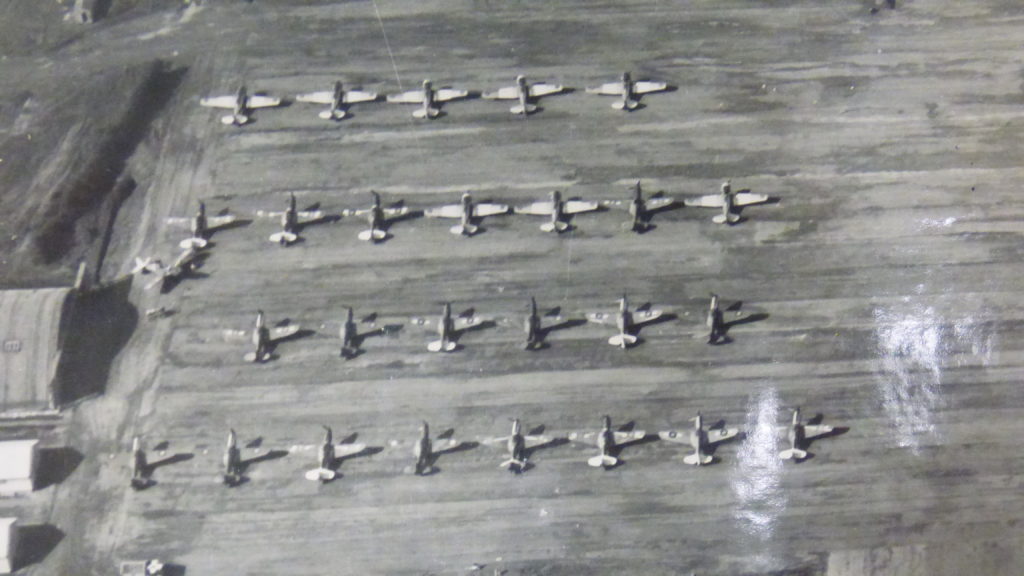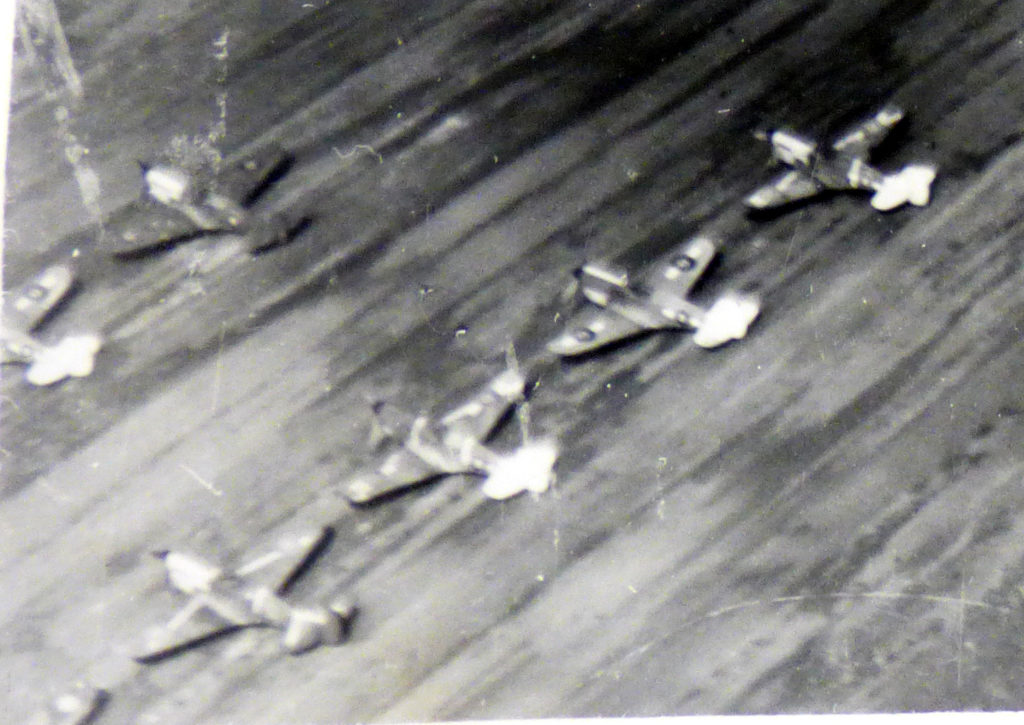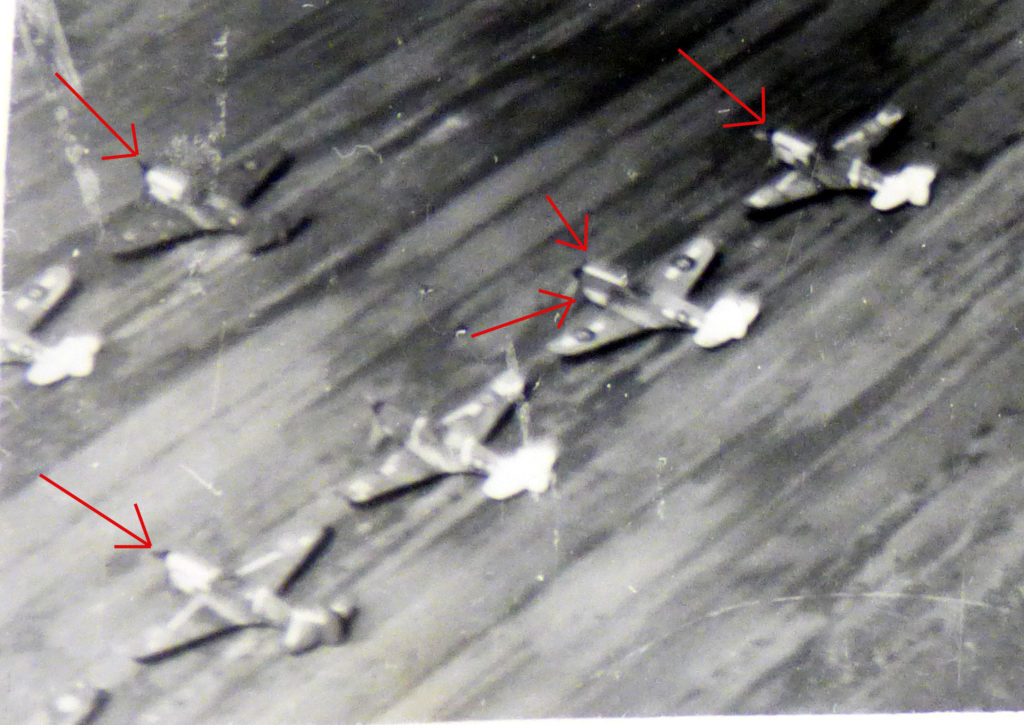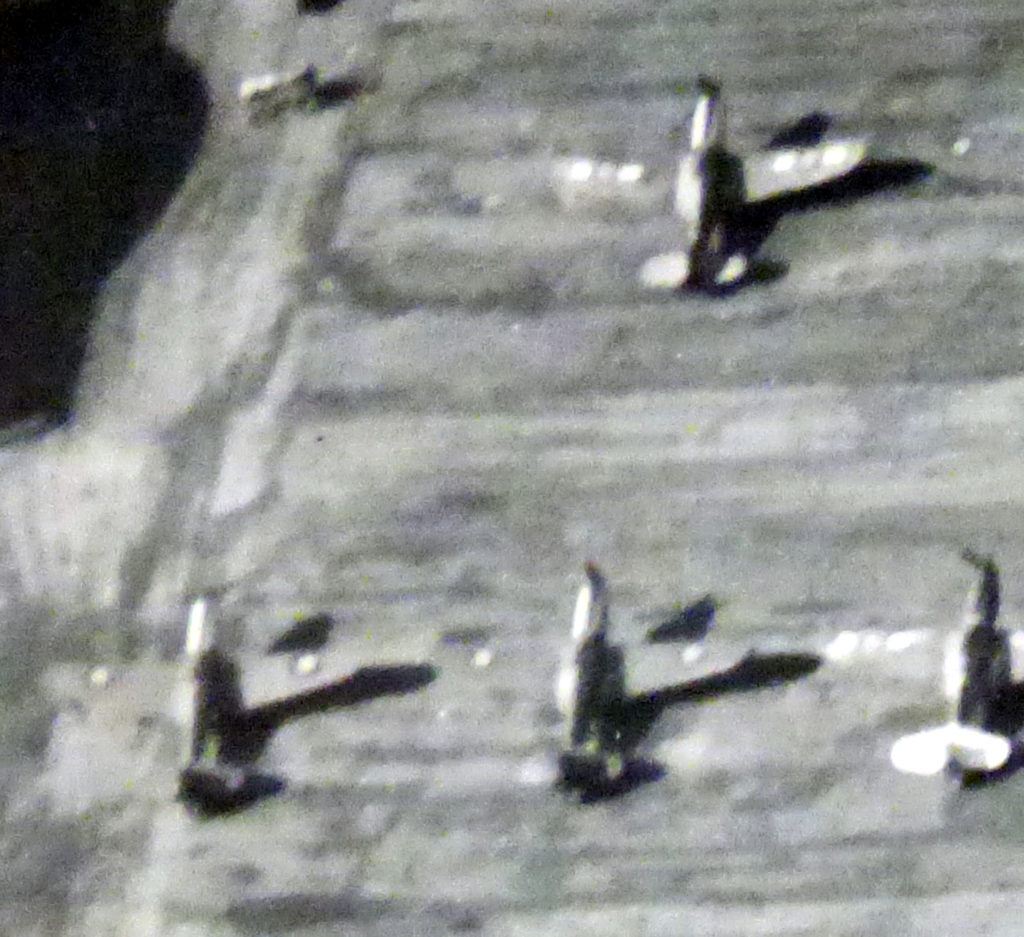|
|
Post by Dave Homewood on Dec 1, 2018 14:56:10 GMT 12
I have stumbled onto a little mystery. When I was at the National Archives in Wellington some time back I was looking at a record they have on RNZAF Small Stations which has a mix of info and photos. There were a load of great photos taken at Ardmore in mid-1944 and although it's really difficult to photograph the photos in the album (because the prints are glossy and the Archive's reading room has loads of overhead lights that reflect on almost every angle) I snapped these two shots because I thought the photos of so many P-40's lined up where NZ Warbirds now is were very cool.   Upon studying these two shots above the other day I noticed that on the bottom left of each there are three P-40's which have what appears to be white noses/cowls. And there's also one that seems to have white stripes! looking at the shadows it is not a trick of the light and not a case of reflections as they are seen in both shots which are different angles. Close up of the first image  Same close up with arrows to make it more obvious  Close up of the second image  Note in the first shot, one aircraft has white Pacific stripes and a white tail; one has Pacific white stripes and no green/OD tail; and the third is just green/OD without any stripes. And the one with the stripey cowl has a white tail and no Pacific stripes. In the second photo there are no Pacific stripes on the aircraft, and no white tails on the bottom two, not sure about the top one but it does not look to be white either. So it seems there may have been five or six different P-40's there with white cowls (one of them being striped?). Does anyone know why? This has even stumped David Duxbury. Might one of the three P-40 Servicing Units that were active at Ardmore from December 1943 through to mid-1944 have had white cowls as a distinguishing feature? Or did maybe instructors fly the white cowled ones so students at No. 4 OTU knew who was who? or David pondered they might have been aggressor aircraft from the Fighter Gunnery School at Gisborne and just visiting, but we have no idea really. What are your thoughts? Has anyone else seen white cowls on RNZAF P-40's before? Is it even white? Maybe yellow? |
|
|
|
Post by saratoga on Dec 1, 2018 15:15:00 GMT 12
Could it be stripped,natural metal?
|
|
|
|
Post by Dave Homewood on Dec 1, 2018 15:24:28 GMT 12
If you look in the first photo near the top there's a Harvard in natural metal with yellow outer wings. Compare the cowls to that, and then the the known white tails, I'd say it's white paint.
|
|
|
|
Post by baz62 on Dec 1, 2018 17:21:53 GMT 12
Strangely when you look at the white/yellow cowlings you see some have the whole cowling set (upper, sides and lower) that colour, some have the top and bottom only and one has sides and bottom only.
I wondered at first, whether we were looking at engine covers but the variation disputes that theory. Any veterans round we can ask? Tell you one thing I'll bet everyone is frantically looking at RNZAF P40 photos a lot more closely right about now!
|
|
|
|
Post by Dave Homewood on Dec 1, 2018 17:46:37 GMT 12
It also amazes me how closely they parked them, wingtip to wingtip.
|
|
|
|
Post by harvard1041 on Dec 1, 2018 17:57:42 GMT 12
HI Dave - I'd guess that these are all 2 (F) OTU aircraft ? - FE codes - which was all white letters, cowls etc .... as opposed to No 4 (F) OTU OD codes which was all red.... old Instructor told me they painted the No 4 OTU aircraft red - lettering cowls etc etc especially when both OTUs moved to Ohakea ... so I'd guess the 2 OTU aircraft could have, using the same theory, - been painted white ?
Makes sense to me...
Cheers
Hvd1041
|
|
|
|
Post by agalbraith on Dec 1, 2018 18:33:35 GMT 12
HI Dave - I'd guess that these are all 2 (F) OTU aircraft ? - FE codes - which was all white letters, cowls etc .... as opposed to No 4 (F) OTU OD codes which was all red.... old Instructor told me they painted the No 4 OTU aircraft red - lettering cowls etc etc especially when both OTUs moved to Ohakea ... so I'd guess the 2 OTU aircraft could have, using the same theory, - been painted white ? Makes sense to me... Cheers Hvd1041 Yes that makes sense, my initial thought was they were white for the same reason 14 sqn painted the cowl on one of their Corsairs white in Japan. maybe there were some close calls mid air and they stood out more like this. Interesting also the roundel shade variation, some dark and some actually fairly light....interesting set of photo's Dave! Great find |
|
|
|
Post by Brenton on Dec 1, 2018 21:13:21 GMT 12
In the top photo the P40's furthest away appear to have white spinners (OTU2) and the closer ones that you take a closer look at have darker spinners (OTU4 with red spinners ? ) Also, none show signs of code letters yet I'd have thought that the white FE codes in particular would have shown up. Perhaps these are planes been repaired and or planes just back from the pacific ? Many of the pranged p40'S were repaired and then put back into service with the other OTU. So repaints were the order of the day. That white look on the cowl could just be part of that process ?
|
|
|
|
Post by Dave Homewood on Dec 1, 2018 21:26:39 GMT 12
HI Dave - I'd guess that these are all 2 (F) OTU aircraft ? - FE codes - which was all white letters, cowls etc .... as opposed to No 4 (F) OTU OD codes which was all red.... old Instructor told me they painted the No 4 OTU aircraft red - lettering cowls etc etc especially when both OTUs moved to Ohakea ... so I'd guess the 2 OTU aircraft could have, using the same theory, - been painted white ? Makes sense to me... Cheers Hvd1041 Nope, this is Ardmore. No. 2 (Fighter) Operational Training Unit formed at Ohakea (originally numbered No. 11 OTU) and was at Ohakea till the end of the war. These aircraft are No. 4 OTU at Ardmore, before it also moved to Ohakea. My understanding is the codes on the No. 2 (F) OTU P-40's were Sky, not white. |
|
|
|
Post by Dave Homewood on Dec 1, 2018 21:31:16 GMT 12
Yes that makes sense, my initial thought was they were white for the same reason 14 sqn painted the cowl on one of their Corsairs white in Japan. maybe there were some close calls mid air and they stood out more like this. There are photos of the odd Corsair with a white cowl ring at Ardmore as well as in Japan so it was not just a No. 14 Squadron thing. I have never worked out why this was done but i did suggest to David Duxbury the other day when we were swapping theories that perhaps there was a connection between the white cowls on these P-40's and those Corsairs with the white rings. Yes. Some of these P-40's arrived at Ardmore from Fairhall with No. 3 SU when they moved there, and others came home from the Pacific. Note how many have strips and white tails and how many don't. |
|
|
|
Post by Dave Homewood on Dec 1, 2018 21:37:12 GMT 12
In the top photo the P40's furthest away appear to have white spinners (OTU2) and the closer ones that you take a closer look at have darker spinners (OTU4 with red spinners ? ) Nope the white spinner ones will be the ex-Pacific P-40's, it was part of their ID, and the dark ones will be green or Olive Drab which was the delivery colours, they'll be the ones from Fairhall or straight out of assembly, I think. The red spinners and codes were not applied to No. 4 OTU aircraft till they arrived later at Ohakea, to differentiate them in the air. The code letters came around mid-year just before they moved to Ohakea I think, or maybe just after they arrived down there. Maybe is is why there were white cowls, to diffentiate between the different Servicing unit aircraft before codes were introduced? Ardmore was not a repair depot. Yes some of these, the ones with the white stripes and white tails, were returned from the pacific but they were in service here as operational trainers. |
|
|
|
Post by davidd on Dec 1, 2018 22:07:26 GMT 12
Even after 4 OTU departed Ardmore for Ohakea, there were still a goodly number of P-40s there (Ardmore) till the end of July. These were the ones equipping the fighter squadrons working up here (of 3, 5, 26 SUs), before they were replaced by F4Us. The FGS arrived at Ardmore from Gisborne in early July 1944, equipped with about half a dozen P-40s and a few Harvards, and remained thus until it was re-armed with F4U-1s, plus remaining Harvards, in November 1944. So far as we know, these aircraft were marked with JZ codes, the group originally allocated to 15 Sqdn, and then handed on to 17 Sqdn.
David D
|
|
|
|
Post by Dave Homewood on Dec 2, 2018 10:01:50 GMT 12
Thanks David. I did not realise the FGS actually moved there from Gisborne, that is interesting. I am almost sure the photos in the album mostly had dates beside them, which would help now. But what you see is what I snapped at the time, as I never expected to find this amazing mystery within.
|
|
|
|
Post by agalbraith on Dec 2, 2018 10:38:22 GMT 12
Amazing these have never been spotted before, even in the background of other photo's until now....
|
|
|
|
Post by Dave Homewood on Dec 2, 2018 11:41:03 GMT 12
Yes, that really amazes me too.
|
|
|
|
Post by davidd on Dec 3, 2018 9:24:50 GMT 12
Another possible reason for marking those P-40s with light-coloured noses might be that these were aircraft designated for use by OTU staff pilot acting as section leaders. By 1944 the RNZAF had joined the rest of the fighter fraternity around the world, and had adopted the four-aircraft section for operational purposes (in fact this process must have started in RNZAF about March 1943 in Fiji when 15 Squadron were instructed in this formation by a US Navy Air Group). Anyway, it was normal by 1944 at RNZAF FOTUs to divide pupils into sections for operational training purposes, with the 4th member being a staff pilot (who would likely have acquired actual operational experience). As aircraft did not normally take off in formation (certainly not in section formation) it meant that the designated formations would have to form up in the air after take off. Having distinctively painted aircraft for section leaders (staff pilots) would have made identification of these leaders a whole lot simpler than trying to read code letters at a distance, although you would have thought that having different colours for each section leader would have made this identification even more useful. However some of the "white" marked aircraft in the photos seem to differ in arrangement from others. Remember that up to 20 or 30 aircraft could be up at any given time, carrying out different exercises, including formation cross countrys, air firing on drogues or "splash" firing into sea, or against ground targets, tail chasing, formation flying, including changing formations, and different sized formations, as well as practice dog fighting were all on the menu. However initial form up of sections immediately after take off would be the most likely time for any confusion to occur, particularly if some pilots (or pairs of pilots) were a bit slow in getting rolling on the runway. Just a wild theory, so all comments welcome. Remember that in the 1930s it was quite common in the RAF (and probably other air forces) to carry strut-mounted streamers or pennants on "leader" aircraft (invariably biplanes) for formation forming purposes, although this form of identification would have been more problematic with faster monoplanes. As to why these markings seem to have been so rarely photographed, all I can suggest is that the distinctive nose markings may have been not that easy to identify from the rear (which is where they late arrivals might be approaching from), and perhaps they may have learned from the RAF that tightening up the procedures and discipline on take offs obviated the need for such markings.
David D
|
|
|
|
Post by Dave Homewood on Dec 3, 2018 10:10:02 GMT 12
I'd think if that was the case that it was for the section leader, we'd see a lot more of them in other photos, and why was it not carried on at Ohakea where there were two OTU's so maybe 50-60 aircraft airborne at once?
Also, as an aside, the day that John Tirikatane was killed at Papakura following a collision in the air between No's 2 and 3 in the fours formation, that formation was led by Trevor Pearce who was also a student on that OTU course. He was flying Doug St George's personal bare metal polished P-40. I wonder if had was given dispensation to lead the four because he'd spent over a year as a Service Pilot previously in Canada on Ansons and Lysanders?
|
|
|
|
Post by davidd on Dec 3, 2018 10:38:01 GMT 12
Dave,
Yes, I believe members of the course could be appointed to section leader status if they were shaping up well in the eyes of the instructional staff, although later (February 1945) the FGS (which was changed in function to the Fighter Leader School, or FLS at this time) was tasked with giving formal training to prospective squadron and Flight commanders, as well as Section leaders. However squadron commanders traditionally could appoint section leaders, or even flight commanders from within the unit during an operational tour to replace lost, sick or injured personnel as well as existing ones who may not be shaping up as hoped, should suitably experienced pilots be available.
As to the reason for why so few of these "marked aircraft" seem to have been photographed, this is covered to an extent in my final sentence in previous post. Remember that the RNZAF Fighter OTUs of 1944/45 were roughly half the size of equivalent RAF units, and with two RNZAF ones at Ohakea from June 1944, that equated to one RAF one. So far as I know, the RAF never found it necessary to have special markings for section leaders in OTUs, so I guess the RNZAF decided to simply drop the whole idea, instead relying on better flying discipline as suggested. Trevor Pearce had experience as a staff pilot in Canada (on Ansons?), and a little with the RAF I think, so must have been a rather higher-houred and more experienced pilot than other course members straight from SFTS, although perhaps a little rusty. I remember reading through his memoirs on this website. Many very experienced instructors from SFTSs and EFTSs were also on OTU course, so would have been likely section leaders in latter stages of their fighter training. Even experienced fighter pilots from the northern hemisphere (RAF or RNZAF) were put through the RNZAF Fighter OTUs as a matter of routine, as the tactics taught in NZ were specifically tailored to Pacific operations, and it also provided conversion to the Corsair, which was a formal course by this time, with a classroom component.
David D
|
|
|
|
Post by Dave Homewood on Dec 3, 2018 10:57:16 GMT 12
Yes Trevor flew mostly Ansons as a Staff pilot and also Lysanders. he never reached Britain though so had no connection with the RAF.
There is a famous photo of a Spitfire Mk 1 that was flown by Ginger Lacey as a Staff Pilot at an RAF OTU while on 'rest' which had a candy-striped nose. And in the early 1990's a Mk 1 Spitfire that was flying in private hands donned that scheme for a short time. I recall seeing it in Flypast magazine. I don't know if it was a Fighter OTU he was on or if he was an aggressor on a bomber OTU though.
|
|
|
|
Post by baz62 on Dec 3, 2018 17:21:34 GMT 12
There is a famous photo of a Spitfire Mk 1 that was flown by Ginger Lacey as a Staff Pilot at an RAF OTU while on 'rest' which had a candy-striped nose. And in the early 1990's a Mk 1 Spitfire that was flying in private hands donned that scheme for a short time. I recall seeing it in Flypast magazine. That's because it was the same Spitfire (AR213 at 57 OTU). |
|
















